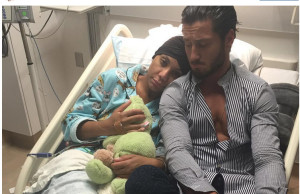DWTS: Week 4 Injury Report

It’s only week 4, but the injuries are piling up on Dancing with the Stars!
We already knew that Maria Menounos has been dancing with 2 broken ribs she got in the early rehearsals, but now we’ve learned that she also has severe bruising and a stress fracture in her right foot.
She was experiencing severe pain in her foot this week and professional dancer partner Derek Hough insisted that she have it checked out.
Dr. Glenn B. Pfeffer, from Cedar Sinai Hospital in Los Angeles, x-rayed Maria’s foot and told her that she had stress reactions and bruising in multiple bones in her foot and that one bone had an actual stress fracture. He was concerned that more fractures would develop and warned that you “can’t dance through broken feet.”
But did that stop Maria? Of course not.
Quitting the show has never been an option and… That’s it. I’m just going to keep pushing through.
Maria and Derek went on to perform a well received tango for a score of 26, although Derek held Maria piggy-backed while they received the judges comments.
There was also an injuries for Little House of the Prairie actress Melissa Gilbert and her professional partner Maksim Chmerkovskiy.
During their paso doble, Maks tripped and Melissa hit her head on the floor. Although she did not appear injured at the time, she began to complain of dizziness and headache, and she was taken by ambulance to the hospital. She later tweeted:
I’m alright. Mild concussion and whiplash. Very soon I will be safely home resting and being taken care of.
The 47-year-old actress did not attend the live results show last night, as she was instructed by her physician to take a rest day.
Gilbert underwent surgery in July 2010 to replace a disc as well as fuse a vertebra in her lower spine. The surgery was considered as a complete success although she had to undergo many months of rehabilitation afterwards.
Partner Maks told host Tom Bergeron that he injured his arm during the dance Monday night, but joked:
Yes, it takes away from the pain in the ankles, knees and shoulders.
Do I Look Stressed?
Stress fractures are overuse injuries.They are most common in the lower legs and feet of athletes, although almost anyone can get a stress fracture.
When muscles become fatigued, they are unable to absorb shock as well. Eventually the muscles transfer the stress to the underlying bones, causing small cracks to form in the bone.
Symptoms include pain, swelling, tenderness to touch at the site of the fracture. Diagnosis can be difficult, since X-rays may be called “negative” until evidence of bone healing begins three to six weeks after symptoms begin.
A “pre-stress fracture” exists when the covering around the bone, called the periostium, becomes inflamed. If treated at this stage, actual fracture may be avoided. Treatment using consists of rest, elevation, immobilization, and over-the-counter pain medications.
Gavin DeGraw to the Rescue
One detail that came out later about Melissa Gilbert’s injury was that fellow contestant, pop singer Gavin DeGraw, carried her down the stairs when she began to feel ill.
DeGraw is well familiar with the symptoms of head injury as he suffered a concussion after being assaulted in New York City in August last year.
A concussion is a traumatic brain injury (TBI) that may result in a bad headache, altered levels of alertness, or unconsciousness.
It temporarily interferes with the way your brain works, and it can affect memory, judgment, reflexes, speech, balance, coordination, and sleep patterns.
Every year, millions of people have a head injury. Most of these injuries are minor because the skull provides the brain with considerable protection. The symptoms of minor head injuries usually go away on their own. More than half a million head injuries a year, however, are severe enough to require hospitalization.
Symptoms of a concussion can range from mild to severe. They can include:
- Altered level of consciousness (drowsy, hard to arouse, or similar changes)
- Confusion, feeling spacey, or not thinking straight
- Headache
- Loss of consciousness
- Memory loss (amnesia) of events before the injury or immediately after
- Nausea and vomiting
- Seeing flashing lights
- Feeling like you have “lost time”
Healing or recovering from a concussion takes time. It may take days, weeks, or even months. You may be irritable, have trouble concentrating, be unable to remember things, have headaches, dizziness, and blurry vision. These problems will probably go away slowly. You may want to get help from family or friends before making important decisions.



























2 Comments